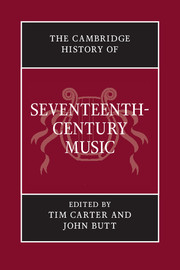Book contents
- Frontmatter
- 1 Renaissance, Mannerism, Baroque
- 2 The seventeenth-century musical ‘work’
- 3 Music in the market-place
- 4 Music in new worlds
- 5 Music and the arts
- 6 Music and the sciences
- 7 The search for musical meaning
- 8 Power and display: music in court theatre
- 9 Mask and illusion: Italian opera after 1637
- 10 The Church Triumphant: music in the liturgy
- 11 Devotion, piety and commemoration: sacred songs and oratorios
- 12 Image and eloquence: secular song
- 13 Fantasy and craft: the solo instrumentalist
- 14 Form and gesture: canzona, sonata and concerto
- Appendix I Chronology
- Appendix II Places and institutions
- Appendix III Personalia
- Index
- References
13 - Fantasy and craft: the solo instrumentalist
Published online by Cambridge University Press: 28 March 2008
- Frontmatter
- 1 Renaissance, Mannerism, Baroque
- 2 The seventeenth-century musical ‘work’
- 3 Music in the market-place
- 4 Music in new worlds
- 5 Music and the arts
- 6 Music and the sciences
- 7 The search for musical meaning
- 8 Power and display: music in court theatre
- 9 Mask and illusion: Italian opera after 1637
- 10 The Church Triumphant: music in the liturgy
- 11 Devotion, piety and commemoration: sacred songs and oratorios
- 12 Image and eloquence: secular song
- 13 Fantasy and craft: the solo instrumentalist
- 14 Form and gesture: canzona, sonata and concerto
- Appendix I Chronology
- Appendix II Places and institutions
- Appendix III Personalia
- Index
- References
Summary
You would hardly believe, sir, the high regard which the Italians have for those who excel on instruments, and how much more importance they attach to instrumental music than to vocal, saying that one man can produce by himself more beautiful inventions than four voices together, and that it has charms and liberties that vocal music does not have.
André Maugars, Response faite à un curieux sur le sentiment de la musique d’Italie (Rome, 1639)In Lorenzo Bianconi’s Music in the Seventeenth Century (1987), arguably the most original and provocative recent study of the period, solo instrumental music is treated so marginally that it is not even given a chapter of its own: ‘In “practical” and statistical terms, the role of seventeenth-century instrumental music is essentially modest and of minority significance – not at all what its relatively profuse cultivation on the part of modern “baroque” musicians would suggest’. It is true that the percentage of purely instrumental volumes among surviving seventeenth-century musical editions is relatively small. Instrumental performances also left much less of a paper-trail than operas, oratorios or major civic or ecclesiastical celebrations. For a historian eager to embed music into larger political, social and cultural frameworks, they tend to remain below the horizon, in part because their functions and meanings are harder to assess.
Nevertheless, the wide popularity of Baroque instrumental music in modern times should be reason enough for giving it attention. In fact, interest in early instrumental repertories, particularly of solo music, is hardly a recent phenomenon. Pianists have been broadening their scope with anthologies of ‘early keyboard music’ since the later nineteenth century, if not before, and most young piano students have been exposed to the easier pieces of Byrd, Purcell and Pachelbel. Similarly, guitarists have been extending their repertory with adaptations of sixteenth- and seventeenth-century lute gems, while chorale settings and preludes from Sweelinck to Buxtehude have long been an important if not indispensable part of the church organist’s working capital.
- Type
- Chapter
- Information
- The Cambridge History of Seventeenth-Century Music , pp. 426 - 478Publisher: Cambridge University PressPrint publication year: 2005



